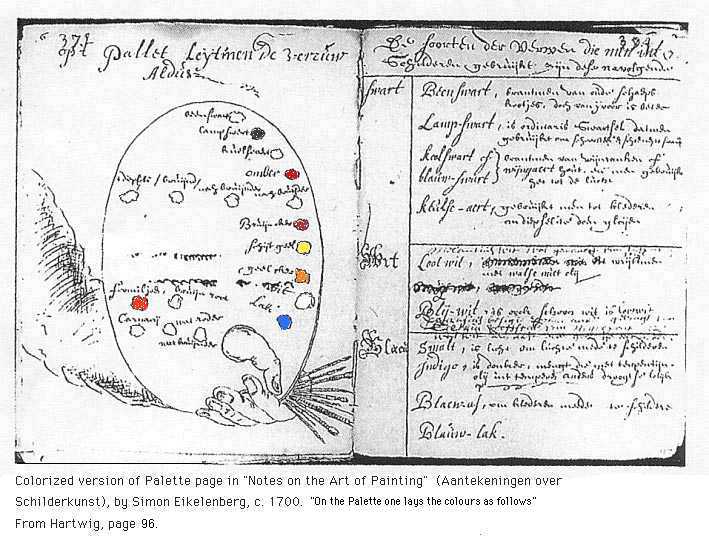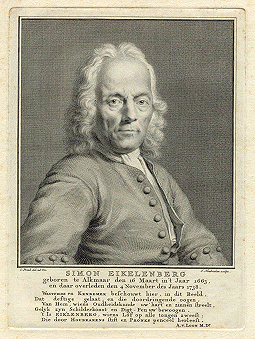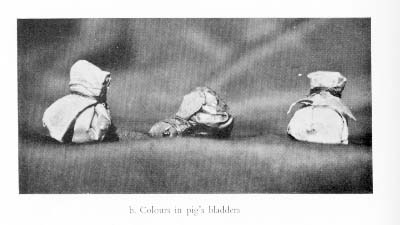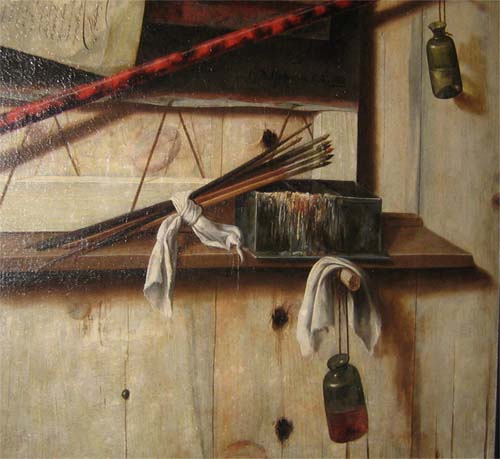Three palettes, 'drye paletten', above in the front room studio, room L.

Read Philip Angel, a contemporary Leiden writer on art theory and practice, 1642
A fine visual explanation has been written by the painter Simon Eikelenberg (1663-1738) in his manuscript Aantekeningen over Schilderkunst [Notes on painting] from 1700. (Regionaal Archief Alkmaar, North Holland, acquisitions collection nrs. 390-394).

 Text
lines from the top, going downwards at the right hand side.
Text
lines from the top, going downwards at the right hand side.
On the palette ons puts the paint as follows: op't Pallet leijt men de veruw Aldus:
Osse swart [ox black]
Lampswart [lamp black]
Koolswart [coal black]
Omber; Dicipili ; bruind ; noch bruijnder ; noch bruijnder [Umber - from left to right: Dicipili, brown, still browner, yet browner ; - the ingredient may be manganese?]
Bruijnoker [brown ochre]
Schijtgeel [also named 'bruin schijt' or 'schietgeel', this fading yellow is an easily fading paint, made from the Rhamnus-berry which also works as a laxatieve]
Geeloker [yellow ochre]
Wit [white]
From left to right: fermiljoen [vermillion red] ; Bruijn root [brown red]; Lake [ blue lacker]
From left to right: Carmozij [Carmine / Lake] ; Wat roder [yet redder] ; Wat bruijnder [ some browner]
Text at the right hand top: "The kinds of paints which one uses in paintings are the following: De soorten der Verwen die men int schilderen gebruijkt zijn dese navolgenden..."
The Simon Eikelenbergs palette - see Ernst van de Wetering "Rembrandt. The painter at work" p. 132ff.
For other painters gear in Vermeer's house see objects in the attic.

 Note
: This object was part of the Vermeer-inventory as listed by the
Delft notary public J. van Veen on February 29, 1676, in the
Thins/Vermeer home located on Oude Langendijk on the corner of
Molenpoort. The painter Johannes Vermeer had died there at the end of
December 1675. His widow Catherina and their eleven children still
lived there with her mother Maria Thins.
Note
: This object was part of the Vermeer-inventory as listed by the
Delft notary public J. van Veen on February 29, 1676, in the
Thins/Vermeer home located on Oude Langendijk on the corner of
Molenpoort. The painter Johannes Vermeer had died there at the end of
December 1675. His widow Catherina and their eleven children still
lived there with her mother Maria Thins.

Detail of a painting showing painters studio gear, a bundle of paint brushes, an open oil tin for cleaning brushes by dipping them in for a longer time. The paint then is released from the brush hairs and slowly sinks to the bottom. The hanging bottles contain a liquid, perhaps a drying agent. Painting by Cornelis Gijsbrechts, coll. Statens Museum for Kunst, Copenhagen.
Illustration of palette from article by Margriet van Eikema Hommes in: Hartwig [_________title/year?] page 96.
Portrait of Simon Eikelenberg, by C. Pronk / J. Houbraken, text by A. v. Loon.
Also note the article by Ineke Pey in Looking Through Paintings The study of painting techniques and materials in support of art historical research, by E. Hermens. ed. De Prom Publishers, Baarn The Netherlands, and St. Leids Kunsthistorisch Jaarboek, 1998
The transcription of the 1676 inventory, now in the Delft archives, is based upon its first full publication by A.J.J.M. van Peer, "Drie collecties..." in Oud Holland 1957, pp. 98-103. My additions and explanations are added within square brackets [__]. Dutch terms have been checked against the world's largest language dictionary, the Dictionary of the Dutch Language (Woordenboek der Nederlandsche Taal , or WNT), which was begun by De Vries en Te Winkel in 1882.
This page forms part of a large encyclopedic site on Vermeer and Delft. Research by Drs. Kees Kaldenbach (email). A full presentation is on view at johannesvermeer.info.
Launched December, 2002; Last update March 2, 2017.
Back to the Welcome page: click Welcome.